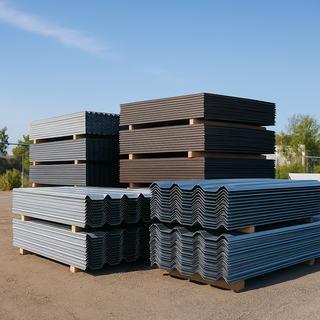When considering roofing options, it's crucial to understand how different materials stack up against each other. In this post, we'll compare metal roofing to other popular materials like asphalt shingles and clay tiles, focusing on four key aspects: lifespan, maintenance, cost, and environmental impact. Additionally, we'll explore the environmental benefits of choosing a metal roof.
Lifespan of Roofing Materials
Metal roofing is renowned for its durability and long lifespan. Typically, a well-installed metal roof can last 40-70 years, depending on the material type, such as aluminum, steel, or copper. In contrast, asphalt shingles—the most common roofing material—have a much shorter lifespan, usually around 15-30 years. Clay tiles, while durable, generally last about 50 years.
Maintenance Requirements
Metal roofs require significantly less maintenance than asphalt shingles or clay tiles. They are not prone to cracking or eroding and are more resistant to extreme weather conditions, including heavy snow, hurricanes, and hail. Asphalt shingles may need more frequent replacement and repairs due to weathering and environmental damage. Clay tiles, though sturdy, can break under impact and may need periodic replacement of individual tiles.
Cost Comparison
Initially, metal roofing is more expensive than asphalt shingles or clay tiles. The cost can be approximately two to three times higher than asphalt shingles. However, the long-term savings make metal roofing a cost-effective option due to its longer lifespan and lower maintenance costs. The higher initial investment in metal roofing can pay off as it is less likely to need replacement or significant repairs.
Environmental Impact
Metal roofing stands out for its eco-friendly properties. It is often made from recycled materials and is fully recyclable at the end of its life, reducing landfill waste. Metal roofs reflect solar radiant heat, which can reduce cooling costs by 10-25% and significantly lower the home’s carbon footprint. In contrast, asphalt shingles are a petroleum product and contribute to higher CO2 emissions during production. Clay tiles, while natural, require a lot of energy for production and are heavier, increasing transportation emissions.
The Environmental Benefits of Choosing a Metal Roof
Choosing a metal roof contributes significantly to environmental conservation. The energy efficiency of metal roofs helps reduce the amount of energy used for heating and cooling, thus decreasing the reliance on fossil fuels. Additionally, the recyclability of metal roofing materials minimizes waste and promotes the use of recycled materials in new roofing projects.
Conclusion
Metal roofing is a superior choice when considering lifespan, maintenance, cost, and environmental impact. While the initial cost is higher, the long-term benefits of durability, reduced maintenance, and environmental friendliness offer substantial advantages over asphalt shingles and clay tiles. You can find more information on the Top Tier Metals' website where you can find the most premium and durable metal roofing solutions.






